2017 Karachi Biennale Artists

Guido van der Werve
Born in 1977 in Papendrecht (The Netherlands)
Lives and works in Berlin (Germany)
Guido van der Werve
Born in 1977 in Papendrecht (The Netherlands)
Lives and works in Berlin (Germany)
Guido van der Werve was raised playing classical piano, but changed to visual arts later in life. He studied Audio Visual Arts at the Gerrit Rietveld Academie in Amsterdam and was a resident at the Rijksakademie van Beeldende Kunsten in 2006 & 2007. He was also part of the International Studio and Curatorial Program in New York, 2008, and resident at the Künstlerhaus Bethanien, Berlin, in 2011. Van der Werve initially started out as a performance artist, but unwilling to perform live and more than once, he began to document his performances. Developing this practice, he quickly got interested in film and cinematography, where he found an emotional directness similar to music, which he saw missing in visual arts. The key element of his works is still performance, but he adds music, text, sport and atmospheric scenes as returning elements. His works are characterized by long meditative shots and a refusal to work with actors. Since 2007 he has composed his own music. Van der Werve has created fifteen elaborate works, which have been exhibited and screened widely, finding recognition in both the art and film worlds. He has received many awards including the Volkskrant Beeldende kunst prijs in 2007, a grant from the Foundation for Contemporary Art in 2008, the Prix International d’Art Contemporain of the Foundation Prince Pierre de Monaco in 2010, the Charlotte Koehler Prijs from the Prins Bernhard Cultuur Fonds in 2012 and the Grand Prix (Gouden Kalf) for best short film at the Netherlands Film Festival in 2013. Van der Werve’s works have been exhibited extensively in venues such as the Kunsthalle Basel, MoMA/PS1, the Venice Biennale, Performa, the Moscow Biennial, the Istanbul Biennial and Manifesta. His works have been acquired by leading museums and institutions, including the Museum of Modern Art in New York, The Goetz Collection in Munich, The Hirshhorn Museum and Sculpture Garden in Washington DC, The Stedelijk Museum of Amsterdam, The Boymans Museum in Rotterdam and the MWOODS museum in Beijing.
Tom Morton has written of Guido van der Werve’s video on view at KB17: “Here, we see the artist walking steadily across the frozen waters, while behind him looms a vast ship, its prow smashing through the ice, then rearing up like a monstrous killer whale. Filmed in longshot, van der Werve seems frail and tiny, forever about to be swallowed by the abyss opening up behind him, forever hearing its great creaks, gulps and rumbles ringing in his ears. The icebreaker, though, lags continually behind, and we get to thinking about the effortlessness of his passage when compared to that of the behemoth to his rear. We might read it as a parable of man’s superiority to machine, until we remember that without the protective shell of the ship, van der Werve would never have been able to reach this inhospitable zone in the first place. This is not an image of man at one with nature, then, but of an excessive survival strategy, both sublime and ridiculous.”

Still from Nummer acht, everything is going to be alright, 2007.
16 mm film to HD, 10:10 min.
Courtesy the artist and Galerie Juliette Jongma, Amsterdam
Guillaume Robert
Born in 1975 in Nantes (France)
Lives and works in Hotonnes (France)
Over the past fifteen years, Guillaume Robert has developed videographic, sculptural and photographic projects and has taken part in collaborative processes and research residencies. He is involved in the Bermuda project, which aims to build a collective art production center in Le Grand Genève. He has had numerous solo and group shows at various art centers and galleries throughout Europe. In 2016, his first monographic publication, Parages, was published by Edition Analogue and Galerie Françoise Besson (Lyon, France). His works are in various private and public collections, including the Fonds National d'Art Contemporain (France).
For KB17, Guillaume Robert has created a site-specific installation, UP TO THE BIG EYE, at the Alliance française de Karachi, from which he has also created a four-minute video work using drone footage with a bird’s eye perspective of the installation. He has also submitted a video called Drina as well as a series of drawings. Of his video and drawings, Robert writes: “Drina shows the reenactment of the building of a mini-hydroelectric station in Goražde (Bosnia). During the siege of the city that took place between 1992 and 1995, these improvised machines were attempts to open up the area — to be able to listen to the radio and gain access to the outside, to have a source of light and to be able to use medical equipment. A similar machine was re-made in Juso Velic's garage in June 2011. The micro-station was set afloat on the river, attached to the main bridge of the city over the Drina. Through this very concrete focal point (the reproduction of a micro-hydroelectric station), the process became one of relaying and documenting a heroic experience: the Goražde inhabitants' resistance to the siege that took place fifteen years before. I will also present ten drawings entitled Points of View. Each of them shows an Algerian watchtower. During and after the Algerian civil war, the military, public services and private companies built many of these lookout points around their infrastructures. I have discreetly photographed some of them and then drawn them as architectural projects or technical drawings.”

Still from Drina, 2012.
HD video, stereo, 22:30 min.
Courtesy the artist and Galerie Françoise Besson, Lyon
Haamid Rahim
Born in 1989 in Lahore (Pakistan)
Lives and works in New York (USA)
Haamid Rahim, aka Dynoman, has been contributing to Karachi's counter-culture music scene since the age of 13. He has played with bands, side projects and began the "Dynoman" moniker in 2009. He co-founded, and continues to run, Pakistan's premiere electronic music record label, Forever South. Rahim has a Bachelor’s from Penn State and a Master’s from Carnegie Mellon.
Rahim writes of his sound work for KB17: “Set in New York City, Talking in Transit highlights the immigration process via audio scenes. The piece captures questions, thoughts, feelings, emotions, and conversations which are prevalent throughout the immigration application, and the piece was inspired by Pakistanis living in New York. The field recordings used are recorded in various parts of New York City and Upstate New York.”

Hamida Khatri
Born in 1985 in Karachi (Pakistan)
Lives and works in Baltimore (USA)
Hamida Khatri works in a variety of mediums — from figurative drawings, to photography, to sculptural puppets, to animation. As well as an artist, she is also a writer, curator, arts educator, community activist, and a creative arts therapist. She holds an MFA in Community Arts and a Certificate in Teaching from the Maryland Institute College of Art (U.S.), Certificate in Humanistic Counseling (U.K.), MBA in marketing (Pakistan), and a BFA in sculpture and photography (Pakistan). She is the Founder and Director of Creative Therapy Platform — A Voluntary Travel-Community Project focused on crafting healing spaces in underrepresented areas. Her recent success lies in the initiation of a social justice community-based venture, [i am] Project KALI – Celebration of Womanhood, in Baltimore, where she has created a safe space for women with a history of trauma and abuse via artistic collaborations and interventions. The project secured grants by The Pollination Project, France-Merrick Opportunity Fund, and Launch Artists in Baltimore Award. By establishing linking platforms, she has been able to curate numerous shows where community participants’ artworks have been displayed, including: Gallery Four, Motor House, Rousse Gallery, Meyerhoff Gallery, and the Baltimore Museum of Art. Khatri has been an artist-in-residence for Elsewhere (Greensboro, U.S.), Khoj International Artists’ Association (India), Uronto Residential Artist Exchange Program (Bangladesh), and Soch Studio (India). She has been widely exhibited in Pakistan, U.S., and Bangladesh, including the Florence Biennale – X Edition in Italy.
Hamida Khatri writes of her submission for KB17: “Hamida Khatri’s current body of work pays homage to her mother who has always supported her dream of having an independent life. The Screenshot Montage is a documentation of her conversations with her mother — living in Karachi, Pakistan — over the phone while being in the U.S. Whereas Mom & Me, a ‘witnessing’ stop-motion animation, portrays the familiarization of the routine tasks she executes every day being in a foreign land away from her mother.”

Still from Mom & Me, 2017.
Stop-motion animation, 4:10 min.
Courtesy the artist

Hamra Abbas
Born in 1976 in Kuwait City (Kuwait)
Lives and works between Lahore (Pakistan) and Boston (USA)
Hamra Abbas
Born in 1976 in Kuwait City (Kuwait)
Lives and works between Lahore (Pakistan) and Boston (USA)
Hamra Abbas received her BFA and MA in Visual Arts from the National College of Arts, Lahore in 1999 and 2002, respectively, before going on to the Universitaet der Kuenste in Berlin where she did the Meisterschueler in 2004. Her works are part of notable international public collections including the Burger Collection, Hong Kong; Vanhaerents Art Collection, Brussels, Belgium; Nelson-Atkins Museum of Art, Kansas, USA; Kadist Collection, Paris, France; British Museum, London, UK; Devi Art Foundation, Gurgaon, India; Kiran Nader Museum of Art, New Delhi, India; Art In Embassies Collection, USA; Koç Foundation, Istanbul, Turkey and Borusan Contemporary Art Collection, Istanbul, Turkey. She is the recipient of the Jury prize at Sharjah Biennial 9, the Abraaj Capital Art Prize in 2011 and was shortlisted for the Jameel Prize in 2009.
Hamra Abbas has two works on view at KB17. In One Rug, Any Colour, she uses a selection of coloured nylon prayer rugs bought by her on Amazon. According to the artist, prayer rugs depicting the Kaaba have recently fallen out of favour, unlike in the past, when such images on prayers rugs were quite common. The artist found it nearly impossible to find one in the markets of Lahore today. The piece recalls an incident on Umrah, when a woman handed the artist one in a small bag as she was leaving the Prophet’s Mosque in Medina. Her own personal Barakah gift, this work also continues the artist’s fascination with colour and of representations of the Kaaba, recalling her 2013 series ‘Kaaba Picture as a Misprint’. The other work, Bodies, was carved from sheesham and then painted by the artist. This hyperrealist sculpture creates icons out of the ordinary and is a testament to the artist’s observance of everyday life in the homes and on the streets of Lahore. Bodies is a group of intricately carved wooden footwear taken from photos Abbas had taken outside the entrances to holy sites and family homes – a marker of segregation between inside and outside, clean and dirty, sacred and the profane. Each of these sculptures has been timelessly rendered, giving the original mundane objects a weight and presence that goes far beyond the accidental.

Bodies, 2016.
Sheesham wood, oil paints
35.6 x 15.2 cm (each)
Courtesy the artist and Lawrie Shabibi, Dubai

Han Seok Hyun
Born in 1975 in Seoul (South Korea)
Lives and works between Seoul and Berlin (Germany)
Han Seok Hyun
Born in 1975 in Seoul (South Korea)
Lives and works between Seoul and Berlin (Germany)
Han Seok Hyun received his MFA from Korea National University of Arts. His work has been exhibited in museums around the world, including The Museum of Fine Arts (Boston); Buk Seoul Museum of Art (Seoul); Total Museum of Art (Seoul); Pohang Museum of Art (Pohang); The Gyeonggi Museum of Modern Art (Gyunggido); the Ilmin Museum of Art (Seoul) and Kunstlerhaus Bethanien (Berlin).
In the installation Super-Natural, on view at KB17, Han creates an undulating landscape of mass-produced green products that he has sourced locally. He writes: “It is, of course, no coincidence that so many companies use the color green to package allegedly healthy goods; marketers associate it with harmony and peace, growth, luck, and energy. The title Super-Natural, a nod to the supermarkets in which these products are sold and to the elevated properties they are claimed to possess, reminds us that these products may be greener in color than in substance. Green hues are often used to make unhealthy products seem more acceptable to impressionable shoppers, and words like natural and healthy have little or no correlation to a product’s contents or to the practices used to produce them.”
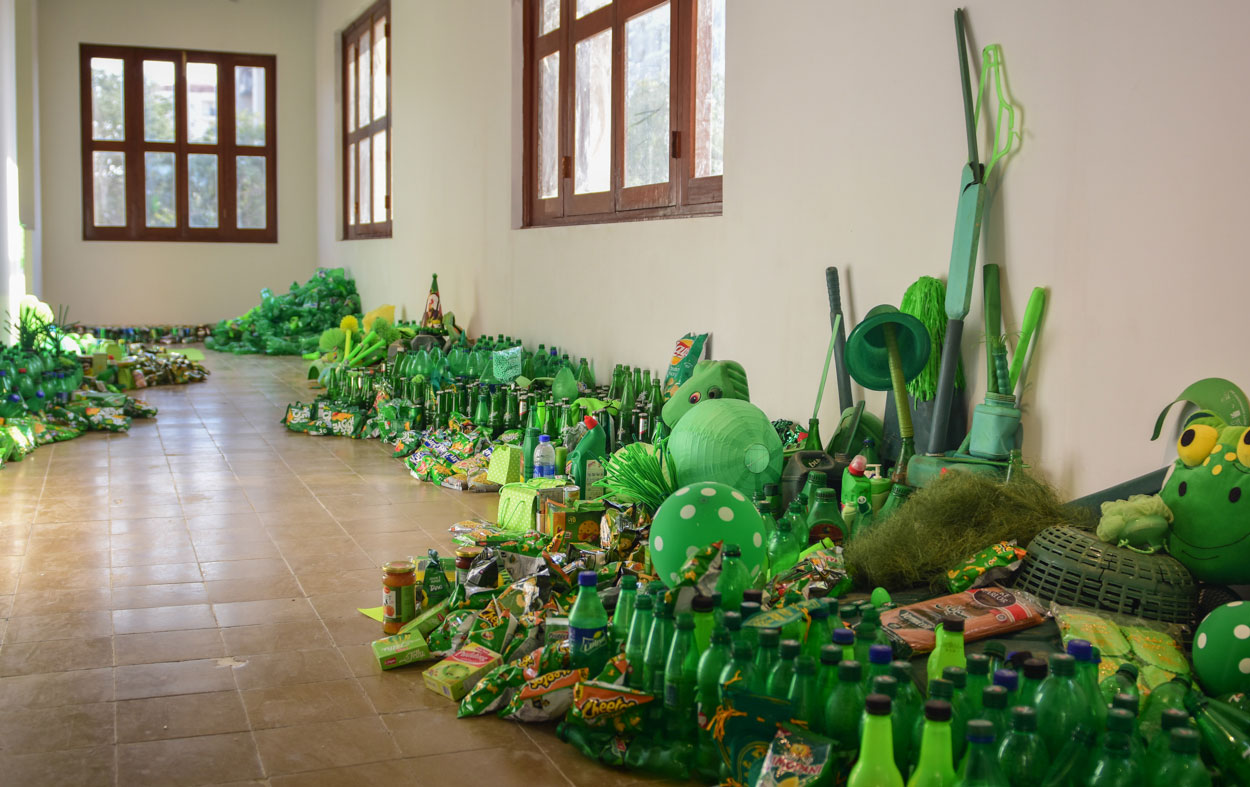
Super-Natural: The Borrowed Landscape, 2016.
Installation with mass-produced green-colored products
Dimensions variable
Courtesy the artist
Heba Y. Amin
Born in 1980 in Cairo (Egypt)
Lives and works in Berlin (Germany)
Heba Y. Amin is an Egyptian visual artist, researcher and lecturer. She is currently teaching at Bard College Berlin, is a BGSMSC doctorate fellow at Freie Universität, and a recent resident artist at the Bethanien artist residency program in Berlin. Amin has received many grants, including the Shuttleworth Foundation Flash Grant, the DAAD grant and the Rhizome Commissions grant. She is the co-founder of the Black Athena Collective, the curator of visual art for the MIZNA journal (US), and curator for the biennial residency program DEFAULT with Ramdom Association (IT). Furthermore, Amin is also one of the artists behind the subversive graffiti action on the set of the television series “Homeland” which received worldwide media attention. Amin has had recent exhibitions at Kunstlerhaus Bethanien Berlin, Kalmar Art Museum Sweden, La Villette Paris, FACT Liverpool, Kunsthalle Wien, the Museum of Modern Art in Warsaw, the Kunstverein in Hamburg, Camera Austria, Berlin Berlinale 9th Forum Expanded Exhibition, the IV Moscow International Biennale for Young Art, and the WRO 15th Media Art Biennale Poland.
Heba Y. Amin writes of her video on view at KB17: “On January 27th, 2011 Egyptian authorities succeeded in shutting down the country’s international Internet access points in response to growing protests. Over one weekend, a group of programmers developed a platform called Speak2Tweet that would allow Egyptians to post their breaking news on Twitter via voicemail despite Internet cuts. The result was thousands of heartfelt messages from Egyptians recording their emotions by phone. A few years later the messages are no longer accessible to the public. Speak2Tweet composed a unique archive of the collective psyche; as the voices disappeared in the depths of cyberspace, this project brings forth the unique narratives and, in turn, connects them once again to the physical realm. Project Speak2Tweet is both a research project and a growing archive of experimental films that utilizes Speak2Tweet messages prior to the fall of the Mubarak regime on February 11, 2011 and juxtaposes them with the abandoned structures that represent the long-lasting effects of a corrupt dictatorship. The project interrogates the re-imagining of the urban myth, of visualizing the city from the ‘personal’ perspective through the highly problematic constructs of (un)democratic tools. It explores the emergence of the imagined city from internal monologues and investigates historical narratives via glitches in digital memory. Through the multi-layered spatial relationships, the project attempts to portray the psychology of the urban realm. As the visual archive grows, Project Speak2Tweet changes and transforms into an altered space that mimics the hallucination of the inner voice.”

Still from My Love for You, Egypt, Increases by the Day from Project Speak2Tweet, 2011.
Video, 6:18 min.
Courtesy the artist
Heide Hatry
Born in 1965 in Sindelfingen (Germany)
Lives and works in New York (USA)
Heide Hatry grew up on a farm in the south of Germany. She left home at the age of 15 to enroll in a sports school, studied art at various German art schools and art history at the University of Heidelberg and taught at a private art school for 15 years while simultaneously conducting an international business as an antiquarian bookseller. Since moving to New York in 2003 she has curated numerous exhibitions in the United States, Canada, Germany and Spain and has shown her own work at museums and galleries around the world, including Mona (Museum for New and Old Art), Tasmania. Australia; Reina Sophia and Fundación Alianza Hispanica, Madrid, Spain; Museum Moyland, Bedburg Hau, and Klingspor Museum, Frankfurt, Germany; Under Heaven Contemporary Art Museum, Beijing, China; and Cultural Institute, Santiago, Chile. Events in conjunction with her exhibitions took place at the New Museum, MOMA PS1, CAA Conference, Deutsches Haus/New York University, Drawing Center, in NYC; and many others. She is represented by Ubu Gallery in New Yorl.
The portraits from Heide Hatry’s series Heads and Tales on view at KB17 are photographic documentations of sculptures addressing issues of violence, death and gender identity. The artist is best known for her body-related performances and her work employing animal flesh and organs. She is often described as a neo-conceptualist and, to the extent that the "space" in which her work operates transcends, transgresses, or transforms the normal relationship of artist to both audience and work, this is accurate – her work does not reside in the pictorial plane, the sculptural space, or filmic time. Among her fundamental preoccupations are identity, gender roles (and specifically what it means to be a woman), the nature of aesthetic experience and the meaning of beauty, the effects of knowledge upon perception, the human exploitation of the natural world, and the social oblivion that permits atrocity to persist in our midst. She refers to her large-scale, usually broadly collaborative, projects, which always involve multiple layers of perception, as Gesamtkunstwerke: she creates the art work, displays it, often in unorthodox ways, composes books and organizes events in which different aspects of performances or texts bring new perspectives to the work.

Jennifer, 2008.
Silver Halide C-Print
50 x 70 cm.
Courtesy the artist
Honi Ryan
Born in 1978 in Melbourne (Australia)
Lives and works in Berlin (Germany)
Honi Ryan is an interdisciplinary artist with a nomadic social practice. Her work has intercultural concerns and deals with the present body in relationship to others and their environment. Working with long term social performance projects at the core of her practice, Ryan builds relationships as works of art by creating mindful encounters in everyday life — encounters between people and place — as a living art practice.
Born in Melbourne, Australia, and based in Berlin, Germany, Ryan has performed, exhibited, published, presented and taught in the arts and at residencies and conferences across Asia, Australia, Europe, South America, and the US. She has been the recipient of numerous scholarships, holds a Bachelor of Visual Art from Sydney College of the Arts where she was valedictorian in 2008, and a Master of Fine Art in creative practice from the Transart Institute in Berlin and New York. Ryan was awarded the Transart achievement award in 2016.
Honi Ryan writes of her project on view at KB17: “The Silent Dinners are a performance art project based around a three course meal. A Silent Dinner is a normal dinner party except the guests are requested not to speak, read or write; not to use technology; and to stay for at least two hours. These social sculptures have been hosted in more than ten countries over the past ten years, for between two and two hundred participants at a time. A platform for experimenting with peaceful exchange, the Silent Dinners break down intercultural barriers such as language, while celebrating cultural expression through food. Each host city fills the experience with a meaning particular to that society, time, group, and individual. The Silent Dinners are an intimate, embodied, cross-cultural portrait of an epoch, highlighting globalisation, the changing nature of communication, and the essential space between people. And, they are a lot of fun.”

The Silent Dinners, 2007 – current.
Social sculpture, 120 min.
Huma Mulji
Born in 1970 in Karachi (Pakistan)
Lives and works in Bristol (UK)
Huma Mulji works with sculpture, photography, drawing and painting, creating material juxtapositions which are attentive to the absurd and broadly address notions of failure and neglect, endurance and transformation. The city, the everyday and the overlooked all serve as subjects in these deliberately awkward artworks, which are materially playful, spatially evocative and imbue an anti-heroism, playing out ironically, or sometimes comically, in her works. Mulji’s participation in recent exhibitions includes: “A Country of Last Things” (solo), Koel Gallery, Karachi, 2016; “The Great Game”, Iran Pavilion, Venice Biennale, 2015; “Burning Down the House”, 10th Gwangju Biennale, South Korea; “Extra|Ordinary”, Dubai, 2013; “Twilight”, a solo show at Project 88, Mumbai, India, 2011; “The Rising Tide”, Mohatta Palace Museum, Karachi, 2010; “Where Three Dreams Cross”, Whitechapel Gallery, London, UK, 2010; “Crystal Palace and Other Follies” (solo), Rohtas Gallery Lahore, 2010; “The Empire Strikes Back”, The Saatchi Gallery, 2010; and “Hanging Fire: Contemporary Art from Pakistan”, at Asia Society, NY, 2009. Mulji was a recipient of the Abraaj Group Art Prize 2013. She was Associate Professor at the School of Visual Arts, BNU, Lahore from 2002-2015 and is currently Visiting Artist 2015-17 at Goldsmiths College, London, visiting tutor BFA program at University of West of England, Bristol, and Lecturer, BA Hons. Fine Art at Plymouth College of Art, UK.
Mulji writes of her site-specific work for KB17: “The installation Ode to a Lamppost that Got Accidentally Destroyed in the Enthusiastic Widening of Canal Bank Road shifts from buoyant absurdity to a paradoxical and monumental decline, simultaneously quiet and disconcertingly momentous. The fallen lamppost flickers, gasping for life, refusing to die. The site of Pioneer Book House, equally worn, gives sanctuary but also illuminates the enormity of the moment, the slow passing of time. The site and the installation within collaborate to form a complex palimpsest of Karachi’s simultaneous and perpetual growth and decline.”

Ode to a Lampost that Got Accidentally Destroyed in the Enthusiastic Widening of Canal Bank Road, 2011-2017.
Site-specific installation
Lamppost, electric cables, LED lights and mixed media
Dimensions variable
Project supported by Plymouth College of Art
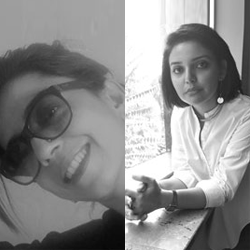
Hurmat Ul Ain/Rabbya Naseer
Born in 1984 in Islamabad (Pakistan)
Lives and works in Islamabad (Pakistan)
Hurmat Ul Ain/Rabbya Naseer
Born in 1984 in Islamabad (Pakistan)
Lives and works in Islamabad (Pakistan)
Hurmat Ul Ain is an interdisciplinary artist and art educationist. Her work is performative in nature and deals with concerns relating to body, gender, food, hospitality and service. She has a BFA from National College of Arts in Painting (2006) and an MFA in Performance Art from School of Art Institute Chicago (2011) where she was studying as a Fulbright Scholar. Ain has been teaching, building curriculum and curating structures for academic archiving at School of Art, Design and Architecture (NUST) in Islamabad since 2011. She has authored published works in journals pertaining to art and design pedagogy in Pakistan and also practices related to visual and culinary arts. Her work has been shown in the US, UK, India, China, Dubai, Japan, Australia, Hong Kong, Germany and Pakistan.
Hurmat Ul Ain writes of her performance with Rabbya Naseer for KB17: “The audience is invited for a sensorial experience as Naseer and Ain shed tears and share intimate stories over the course of a long durational performance. The chopping of onions, a mundane and domestic task, is accompanied by story-telling as a distraction, but also as a reward, for bearing the sting. The work is durational and may be experienced at any moment in time depending on the endurance of the audience.”
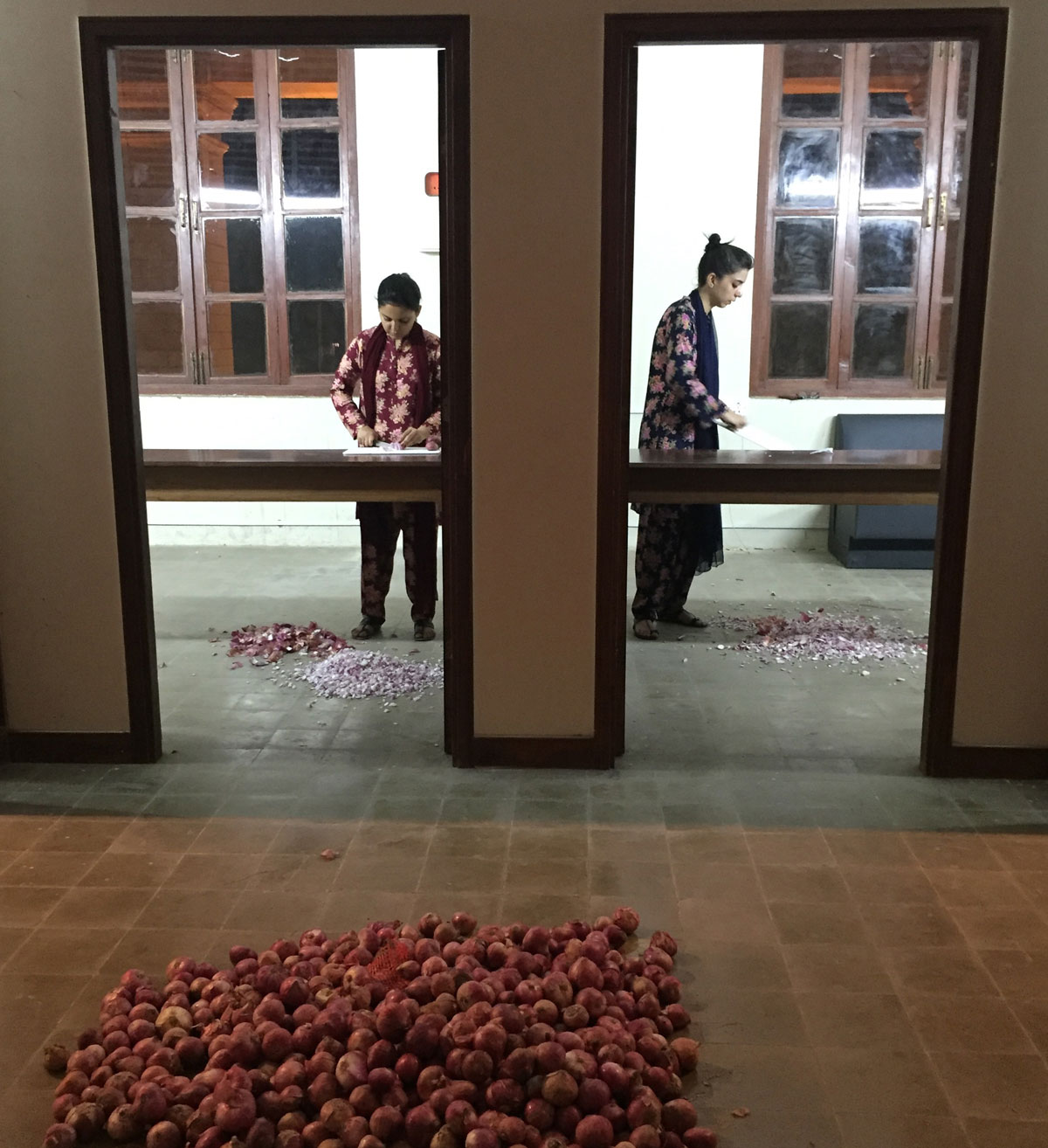
Dropping Tears Together II, 2009.
Performance
240 min.

Imran Channa
Born in 1981 in Shikarpur (Pakistan)
Lives and works between Lahore (Pakistan) and Maastricht (The Netherlands)
Imran Channa
Born in 1981 in Shikarpur (Pakistan)
Lives and works between Lahore (Pakistan) and Maastricht (The Netherlands)
Imran Channa completed his BFA at the National College of Arts, Lahore, wherefrom he also obtained an advanced degree in 2008. Channa’s work has been shown across the world in numerous exhibitions at venues such as: The House Mill, London; Marres Museum, Maastricht; and Artport, Tel Aviv, as well as international art fairs, including the Third International Festival of Contemporary Art at the Museum of Modern and Contemporary Art Algeria and Art Basel Hong Kong. He has had solo shows at Koel Gallery (Karachi) and the Mohatta Palace Museum (Karachi), and received the ‘Award of Excellence’ by the Artists’ Association of Punjab in 2013. He is currently participating in an artistic-research residency program at the Jan van Eyck Academie, Maastricht (The Netherlands), and teaches at the National College of Arts, Lahore. Channa’s primary artistic interest is in historical documentation; how it creates narratives and provides a vehicle for erasure, simultaneously a source of information and information. His multi-medial approach uses drawing, moving image, installation and digital technology as a means to re-examine historical documents and their influence, inviting audiences to contemplate the contradictions of how we record and understand history.
Imran Channa’s installation for the Karachi Biennale 2017, The Great Wall, explores the concept of the wall, not only as defining physical space but also confining ideologies, an embodiment of the dialectic tension between concealing and revealing. The project plays with the idea of creating a wall, used to establish and divide physical and ideological space on the basis of socio-political history, religion and culture. The disrupted nature of the physical manifestation of the installation explores questions of the constraints of context on the artistic process, treated by the artist as a metonym for the effect of socio-political conditions on creative thought and output more generally. Channa’s wall exists, like all walls, in a very specific, finite plane of time, as the artist himself says: “It explores and records the discursive traces of time.”
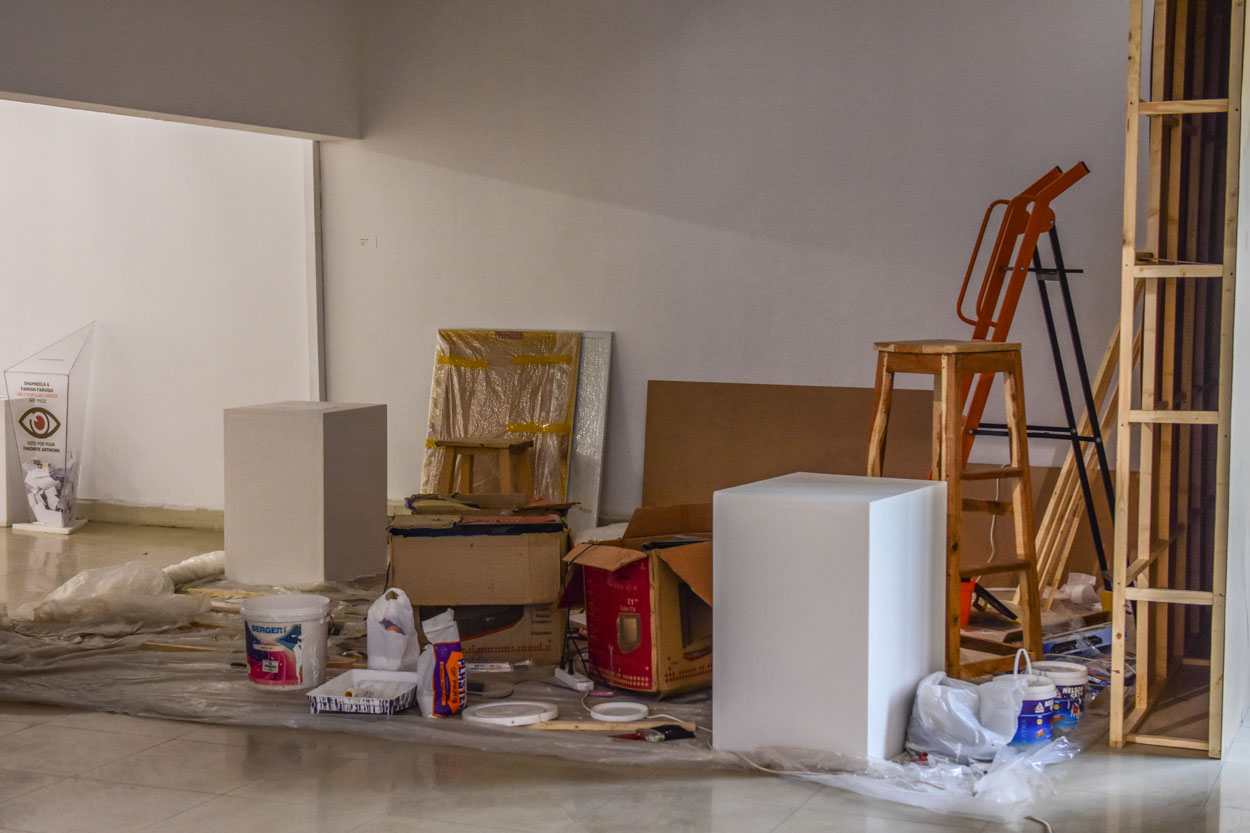
The Great Wall, 2017.
Installation
Dimensions variable
Imrana Tanveer
Born in 1985 in Sialkot (Pakistan)
Lives and works in Karachi (Pakistan)
Imrana Tanveer is a Karachi-based artist whose work incorporates weaving and textiles, appropriating iconographical images from art and culture to address socio-political issues, both locally and globally. Her multi-medial practice synthesises imagination and reality, extricating a complex visual dialogue which simultaneously deconstructs our collective realities and reconstructs an imagined reality, scrutinising and transmuting the world in which we live. Tanveer holds degrees from the National College of Arts, Lahore, and Textile Institute of Pakistan, Karachi. Having won the International Emerging Artist Award in 2016 in Brussels, Belgium, she is currently one of thirty finalists for the Sovereign Asian Art Prize, and her work has been exhibited throughout the world. Islamic Art Magazine featured Tanveer’s first solo show in its top ten solo and retrospective exhibitions of 2013, and her work is part of highly-acclaimed collections such as that of the British High Commission, Islamabad; the Ierimonti Gallery, USA; and the AAN Collection, Pakistan.
In her work for the Karachi Biennale 2017, Construction/Deconstruction: The Work is Present, Tanveer has reprocessed one of her previous installations, Post Betrayal (2012), in which she applied her textile practice to create a camouflage parachute, using digital mapping to place the work in a series of international galleries and museums, primarily in the United States. Thus, her work wittily comments on the primary aim of many peripheral art practitioners; to have their work exhibited in the Western centers of power in the global art world, by placing one of her previous works in a litany of Western institutions. The work’s satirical commentary on the implications of the North-South axis of power in contemporary art is strengthened by the underlying exploration of the definition of art in the digital age, wherein interactivity and virtual reproduction are a reality, calling for, in the words of Tanveer, “a new conceptual understanding of different techniques, production and display methodologies.”
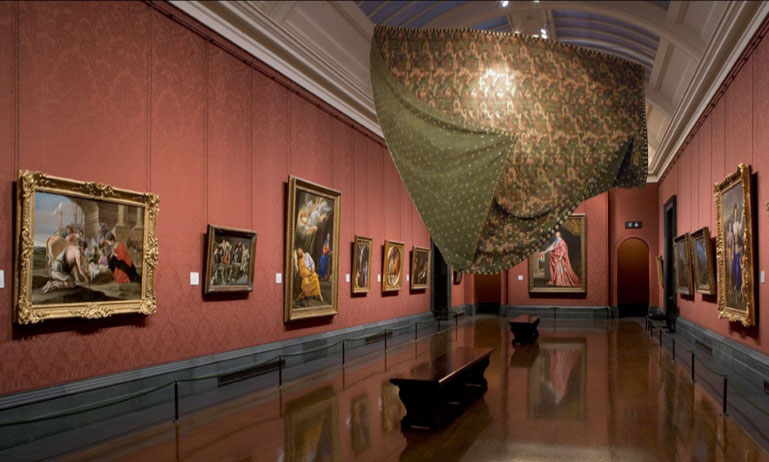
Construction/Deconstruction: The Work is Present, 2017.
Video, 2 min. on loop.
Courtesy the artist
Irfan Hasan
Born in 1982 in Karachi (Pakistan)
Lives and works in Lahore (Pakistan)
Irfan Hasan obtained his BFA (with Distinction) from the National College of Arts, Lahore majoring in Indo-Persian miniature painting in 2006, winning the award for ‘Best Young Painter’ from the Punjab Arts Council the next two successive years. He has also attended a variety of residencies, such as: Art OMI, New York; Storefront Artist Project, Massachusetts; Vasl Artist’s Collective, Karachi; and the Commonwealth Connection International Fellowship at GCAC, Kolkata. Hasan has participated in numerous group and solo exhibitions, both nationally and internationally. He is currently teaching at the National College of Arts, Lahore. His art practice absorbs both eastern and western influences; his training as a miniaturist has shaped his technical practice, yet the canonical European portraiture has been his point of reference. In the artist’s words, “My works are an homage to the portraiture of the European masters and the practice of stylization within IndoPersian miniature painting; a personal synthesis of aspects of classical portraiture and miniature painting.”
Hasan’s painting for the Karachi Biennale 2017, Holy Man, epitomises his artistic practice. His work is a tribute to Abu’l Hasan Khan Ghaffari Kashani, commonly known as Sani ol molk, one of the master watercolourists in the Qajar court in Iran. In his emulation of Sani ol molk’s works, Hasan has utilised a traditional technique of Mughal and Persian miniature painting – hand-ground opaque watercolour and gouache on paper. However, the subject of Hasan’s portrait is represented in profile and naturalistically, forcibly recalling the portraiture of Piero della Francesca. This reveals Holy Man as an intersection of art historical influences, synthesised by Hasan as the contemporary mediator. Indeed, it is a fitting homage to Sani ol molk, who himself spent four years in Italy, studying the works of Italian masters, before returning to the Shah’s court. Hasan’s performative painting, Self-portrait, is also part of the Karachi Biennale 2017.

Holy Man, 2017.
Opaque watercolour on paper
102 x 152 cm.
Courtesy the artist
Ivan Lam
Born in 1975 in Kuala Lumpur (Malaysia)
Lives and works in Kuala Lumpur (Malaysia)
Ivan Lam graduated with a BA in Fine Art (majoring in painting) from the Maine College of Art USA in 1998 and returned to Malaysia to begin his career as a fine artist. Lam’s works span a variety of mediums and ideas inspired by popular culture, autobiography, current affairs and every day vistas. The concept of duality has been continuously present throughout his journey as an artist, with contrasts and opposites always playing a role in his works. In 2015, Wei-Ling Contemporary held a comprehensive survey documenting twenty years of the artist’s practice, entitled Ivan Lam: TWENTY. In 2013, Lam participated in Art Basel Hong Kong with the exhibition COMA – Compendium of Malaysian Art. And in 2016, Lam participated in Volta New York.
For his video for KB17, Lam references a workshop he conducted with students earlier in the year at the NJV Building, one of the principal sites of KB17. He states: “The artwork that I will be showing is the last of its many incarnations--from the workshop with the NJV students, to the building of a three dimensional color wheel, and now to this video installation. The video consists of moving images of all the artworks the students did during the workshop, along with some hidden footage blended in. It's a pensive work; the color dots lull in a maze of quiet discontentment and beauty.”
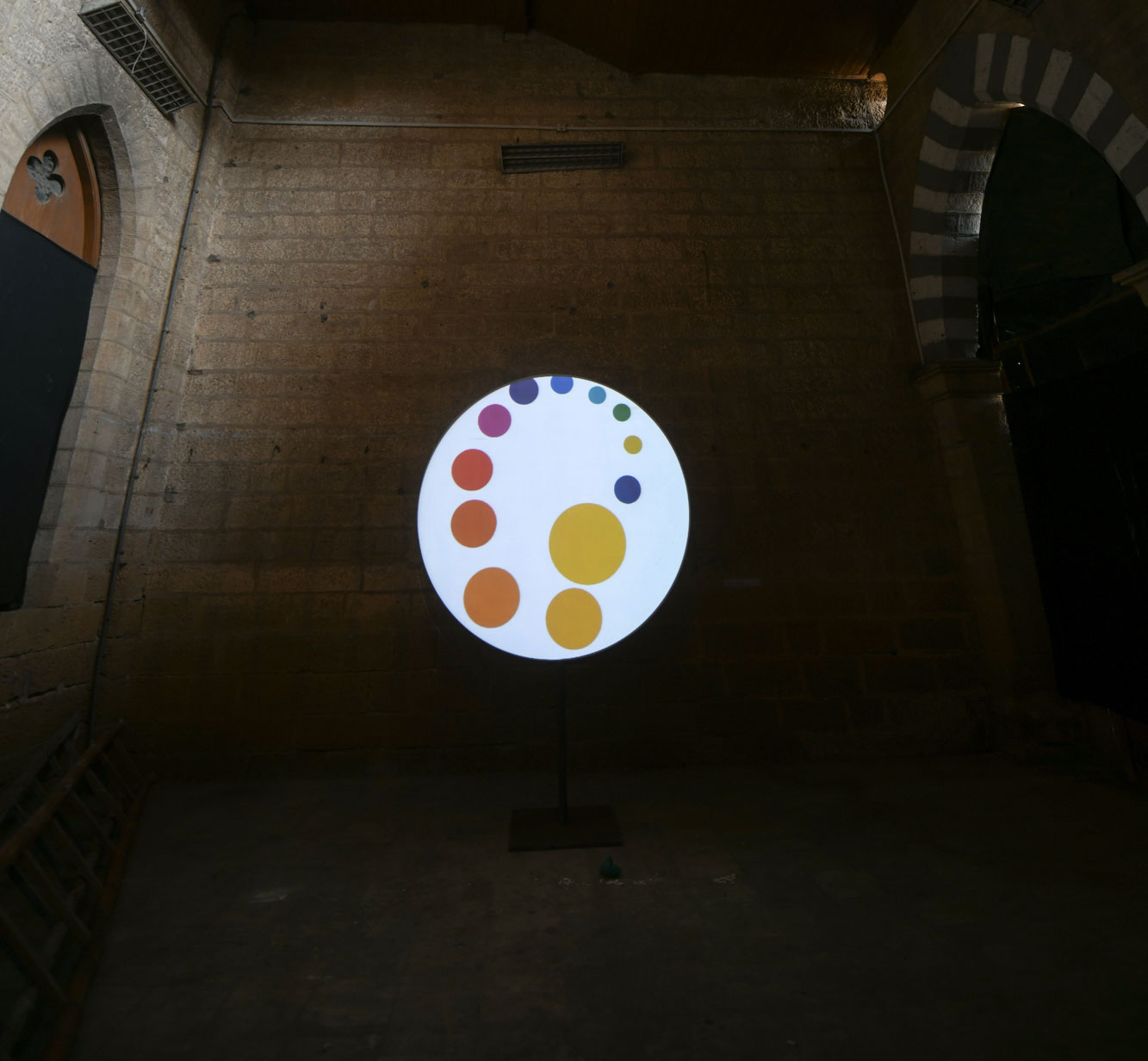
You Said You’ll Never Leave, 2017.
Single channel video, 100 min. (looped)
Courtesy the artist and Wei-Ling Gallery, Kuala Lumpur
Izdeyar Setna
Born in 1977 in Karachi (Pakistan)
Lives and works in Toronto (Canada)
Izdeyar Setna received his Diploma (Photography) from New England School of Photography and Bachelor of Fine Arts (Photography) from Parsons School of Design, New York. He won first place in the American Society of Media Photography (ASMP) student competition in 2003 and also received the Judges’ Choice Award. BBC News selected Setna’s photograph to be part of their fifteen best images of 2004. In 2006, Christies auctioned his work for Nokia. Setna’s work was chosen to represent Pakistan at Chobi Mela, Bangladesh. In the Art of Photography Show, San Diego, USA in 2010, his photograph was one of those selected by Natasha Egan (Director and Curator at the Museum of Contemporary Photography in Chicago, USA). In 2012, Christies once again auctioned his photograph for Standard Chartered Bank for their theme “Seeing Is Believing” in Dubai. Two of Setna’s images will be included in the upcoming book Identities Now– a collection of best contemporary portrait photography selected from across the globe.
Izdeyar Setna has submitted three photographs for KB17. He states: “When you look closely at the images you will see a collage of numerous semi out-of-focus images. These numerous images create a face within a face that represents a human being who has seen, experienced and witnessed time. A witness is an observer, onlooker or even a spectator. The people in my photographs have been digitally manipulated with multiple images taken by me to create an illusion of what I have witnessed in the course of my life. These images are not meant to be clear. They're meant to create an illusion of what goes on in one's mind.”

Standing Boy, 2017.
Digital photograph on semi matt paper
76 x 102 cm.
Courtesy the artist
J&K
Live and work in Berlin (Germany) and Copenhagen (Denmark)
The artist duo J&K are Janne Schäfer (b. 1976 in Darmstadt, Germany) and Kristine Agergaard (b. 1975 near Copenhagen, Denmark). They have been working in collaboration since 1999 and are based in Berlin and Copenhagen, respectively. J&K have had numerous international solo shows and participated in many group exhibitions at, among other places, Mathaf, Doha; Institut du Monde Arabe, Paris; IVAM, Valenica; Museum for Egyptian Art, Munich; Latvian Centre for Contemporary Art, Riga; NGBK+ Kunstraum Kreuzberg, Berlin; Kunsthal Nikolaj, Copenhagen; Galerie im Körnerpark, Berlin; Den Frie Centre of Contemporary Art, Copenhagen and the Liverpool Biennial.
Mammal Matrix (MaMa) is a new video work by J&K created for KB17. The video consists of a looped animation of still photography images showing a colourful and vividly textured composition of bedding materials, fabrics and objects in constant transformation seen from a bird’s eye view. The painterly scenarios reference death and birth beds, and bear witness to possible rituals and stages of passage that are lived and performed in them. The image sequence is accompanied by spoken text taking the audience on a cosmic journey through multiple states of birth and death, from the edge of the universe into a womb on planet Earth. The protagonists of this journey are a basilosaurus, a chicken, a sesame seed and a meteorite: phenomena that are all loosely referencing the ancient cultural and geological history of the region that makes up today’s Pakistan. Mammal Matrix (MaMa) is offering a zoomed-out perspective on life as a continuous cycle in which being-hood shifts and where the man-made categories and borders between human and animal species, plants, minerals and things are questioned and explored. The work is shown as a projection within a full-floor installation composed from various soft materials allowing the audience to sit or lie down and experience the work as a form of guided meditation on the transient mysteries of life and death. The floor installation partly references the aesthetics of the video and blends it with local materials creating a communal patchwork. Mammal Matrix (MaMa) was created while J&K were personally facing actual birth and dying processes and the artists wish to thank Linards Kulless (production assistance) and Fritz Stollberg (photography and edit) for their great personal and artistic support. Text for the video was written with and spoken by Jonathan Bonnici. The work was realised with financial support from the Danish Arts Foundation.
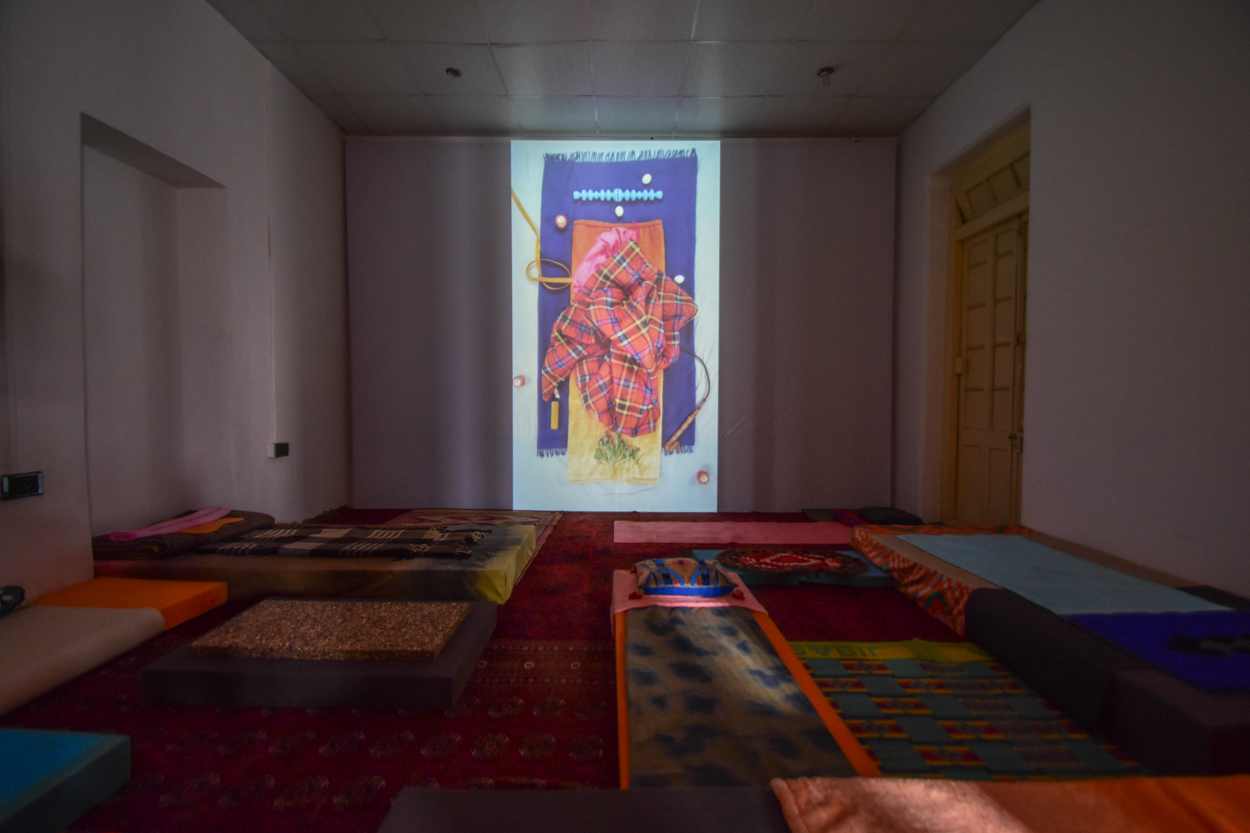
Mammal Matrix (MaMa), 2017.
Video installation, 12:28 min.
Courtesy the artists
James Beckett
Born in 1977 in Harare (Zimbabwe)
Lives and works in Amsterdam (The Netherlands)
James Beckett’s research-based practice explores minor histories, mostly concerned with industrial development (and subsequent demise) across Europe, a process of investigation which is as much physical as it is biographical. Museological display mechanisms are key in Beckett's presentations, with craft-like assembly placing the work uncomfortably between a bourgeois decorative art and a crude social reality. His more recent works focus on the disparate practices of architecture and dentistry and the more metaphysical subculture of dowsing. His recent shows include: T293, IT (2017); 56th Venice Biennale, Belgian Pavilion, IT (2015); 5th Thessaloniki Biennale, GR (2015); Markus Lüttgen Galerie, DE (2015); Wilfried Lentz, NL (2015); Artspace, Aukland/Physics Room, NZ (2014); steirischer herbst, AT (2013); TWAAS, US (2013); Stedelijk Museum, NL (2012); CCA Wattis, US (2012); Dak’art, African Biennale, SG (2012); T293, IT (2011). In 2003 he received the Prix de Rome for art and public space, and has published two monographs: Constant Interjections, TWAAS/Koenig books (2013) and James Beckett, Kehrer Verlag (2009).
James Beckett writes of his installation for KB17: “I would like to connect quite solidly and coherently to the idea of ‘Witness’, but choose not to do so in the most obvious of ways. As a starting point, I intend to look toward the Theatre of the Absurd. In its famous dictum: logical construction and argument gives way to irrational and illogical speech and to its ultimate conclusion, silence. I see potential in such silence, for that too of the witness. Overwhelmed, dumb-struck, numb: a frozen spectator - yet a subject by all means. For Karachi, it is not a theatre piece or a play I will attempt, or even a documentative form for these players, but a research project looking to connect contemporary and historical moments, to find a form or a manifestation of ‘witness’ through the lens of the absurd. At this moment I am looking at the so-called ‘dynmamic back lights’ of Audi A6/A7 sedans. The indicator of these lights is animated, so that LEDs move in sequence in the direction the driver intends driving. It is a kind of over-explained gesture, or sign - a point where technology becomes patronising by over-developing already well functioning systems. I find this to be an appropriate metaphor for the times in which we live. In research I intend to expand on such a collection, to the formation of an installation to be titled Simple Indicators. My resulting work primarily hopes to engage and activate a public in Karachi, but purposefully looks for a more sublime and subliminal fashion. It is in this sense I see this opportunity to show in the Biennial, as a chance for experiment and change.”
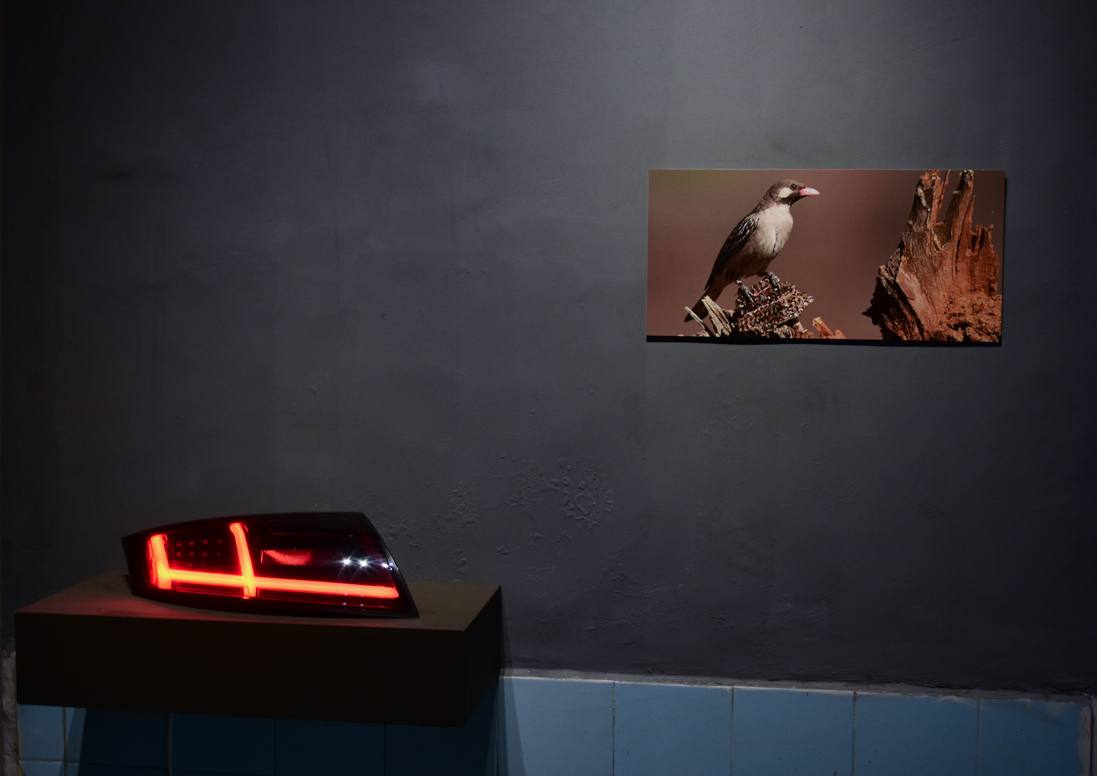
Simple Indicators, 2017.
Mixed media installation
Dimensions variable
Courtesy the artist
Photo of the artist by Janiek Dam
Jamil Baloch
Born in 1972 in Noshki (Pakistan)
Lives and works in Lahore (Pakistan)
Jamil Baloch is a multi-disciplinary artist whose work narrates the impact of socio-political division in our societal structures. He obtained his BFA from the National College of Arts, Lahore, in 1997. His work has been shown in a number of solo exhibitions, at galleries including: Sanat Art Gallery, Karachi; Couadro Art Gallery, Dubai; ArtChowk Gallery, Karachi; Canvas Gallery, Karachi; Vermont Studio Center, USA; and Gandhara Art Space, Karachi. His work has been exhibited extensively in group shows, both nationally and internationally, in countries such as: USA; UK; UAE; France; China; Japan; Bahrain; Bangladesh; Sri Lanka; and Malaysia, as well as the Sea+ Triennale in Indonesia. He has also won several awards, including an Honourable Mention Prize at the 13th Asian Art Biennale, Dhaka. He currently teaches at the National College of Arts, Lahore. His art practice draws from the world that surrounds him, aesthetically and conceptually, and this has entailed a multi-disciplinary approach, spanning sculpture, drawing, painting, new media and mixed-media installation.
Baloch’s sculptural installation for the Karachi Biennale 2017, Mega Project, revolves around the concentration of power within the elite, and how such an imbalance tramples those outside of this circle of society. Whilst the work can be read as a critique of the social structure of Pakistan, and the inspiration derives from the artist’s own region, Balochistan, it transcends specific categorisation as such. Rather, Mega Project denounces a pervasive, universal exploitation of human rights and the malefaction of those in positions of power and authority, denying the majority opportunities whilst projecting this duplicitous denial as for the people’s betterment, in order to maintain their own bloated status. This is perfectly captured by the visual allegory visible in Baloch’s sculptural installation; the anonymous, enwrapped bodies, with tyre tracks displacing their forms, symbolise the elite’s detached disregard for the downtrodden.
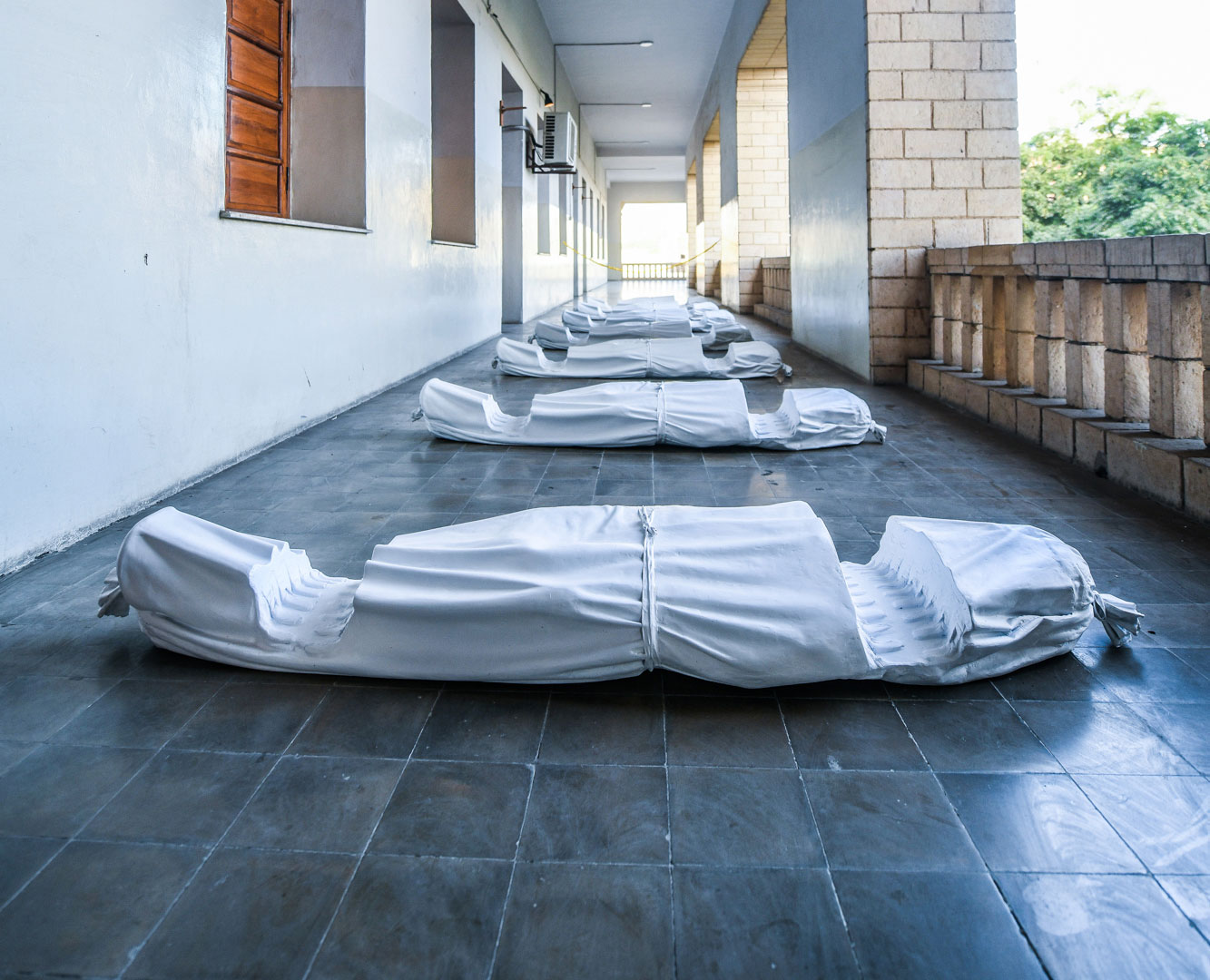
Mega Project, 2017.
Fiberglass
Seven works, 178 x 55 x 30 cm. each
Courtesy the artist
Jamil Dehlavi
Born in Calcutta (India)
Lives and works between Karachi (Pakistan) and London (UK)
Jamil Dehlavi is an independent filmmaker who read law at Oxford University and was called to the Bar at Lincoln’s Inn in London. He then studied film directing at Columbia University in New York where he received a Master of Fine Arts. He has written, produced and directed many international award-winning feature films and documentaries including TOWERS OF SILENCE, THE BLOOD OF HUSSAIN, BORN OF FIRE, IMMACULATE CONCEPTION, PASSOVER, PASSION IN THE DESERT, JINNAH, INFINITE JUSTICE, GODFORSAKEN, SEVEN LUCKY GODS and BLOOD MONEY. His practise as a visual artist examines the relationship between the static and moving image while also investigating the intersection of sculpture and digital art.He has exhibited his work at UNESCO in Paris and at Amin Gulgee Gallery and KOEL Gallery, both in Karachi.For the last four years he also worked as an Associate Professor at the School of Arts, Humanities and Social Sciences at Habib University, Karachi where he taught film production.
Jamil Dehlavi writes of Ghosts, which he made for KB17: “My work for the Biennale is a series of images extracted from 8mm film which my father shot in the 50s. The footage deteriorated over the years and I managed to salvage some frames which capture a sense of memory through fading and disintegrating images. These works are suggestive of the presence of absence and the fragility of life, evoking memories which are both personal and collective.”

Ghosts, 2017.
Archival prints on metal
244 x 30 cm.
Courtesy the artist

Jason Mena
Born in 1974 in New York (USA)
Lives and works between Puerto Rico and Mexico City (Mexico)
Jason Mena
Born in 1974 in New York (USA)
Lives and works between Puerto Rico and Mexico City (Mexico)
Jason Mena is an interdisciplinary artist examining patterns and contradictions in a social formation, focusing mainly on the informal sector, its broad economic structure, and its prevalence and diversity in all social classes. He received a BFA from Escuela de Artes Plásticas y Diseño (EAPD) in Puerto Rico and attended Milton Avery Graduate School of the Arts (Bard College MFA Program) in New York, earning his Master's degree from the School of Visual Arts (SVA). His work has been exhibited individually and as part of collectives in venues including the Museum of Contemporary Art and Design (MADC) in Costa Rica; Modern Art Museum (MAM) in the Dominican Republic; Unicorn Centre for Art in Beijing; National Museum of Fine Arts (MNBA) in Argentina; Hessel Museum of Art in New York; Ex Teresa Arte Actual and Carrillo Gil Contemporary Art Museum (MACG) in Mexico City; Wattis Institute for Contemporary Arts (CCA) and Museum of Latin American Art (MOLAA) in California; National Center for Contemporary Arts (NCCA) in Moscow; Massachusetts Museum of Contemporary Art (MASS MoCA) in North Adams; Puerto Rico Museum of Contemporary Art (MAC) and the 2nd and 3rd editions of The San Juan Poly/Graphic Triennial, among others.
Jason Mena has submitted a video for KB17 called Fault Line as well as a series of photographs entitled Failed States. Fault Line is a drawing in motion; a mark that delineates geographies, that conforms and forms, but also one that represents occupation and rupture. In a symbolic gesture, a continuous line is drawn with chalk marking the perimeter of Unidad Habitacional Nonoalco-Tlatelolco. Here, chalk—a porous material frequently employed for didactic purposes—represents and traces a jagged and rough historic route that paradoxically disrupts the linear conception of history. Failed States, a commentary on the G-7 group of industrialized nations, is a photographic documentation of an action, where the body is employed as a geopolitical metaphor ultimately subdued to its immediate context.

Still from Fault Line, 2012.
Video, 2:24 min. Resolution: 4:3
Dimensions variable
Courtesy the artist
Curated by Carlos Acero Ruiz.

Jean Hubert
Born in 1987 in Ivry-sur-Seine (France)
Lives and works between Paris (France) and Amsterdam (The Netherlands)
Jean Hubert
Born in 1987 in Ivry-sur-Seine (France)
Lives and works between Paris (France) and Amsterdam (The Netherlands)
Jean Hubert graduated in 2010 from the Ecole Nationale Supérieure des Beaux-Arts de Paris (Ensba). During his coursework, he also studied video for one year at the Emily Carr University in Vancouver. He has participated in several exhibitions in France and abroad, notably, “Visio Schermo del Arte,” (Teatro la Compania, Florence, 2016); “The Time I Spent Going Nowhere,” (Billytown, La Haye, 2016); “Personal Science Solution Is For Me,” (Momart, Amsterdam, 2015); “The Script Inside Me Ep- 01,” (Fondation BilbaoArte, Bilbao, 2014); “The Great Indoors” (Motive Gallery, Brussels, 2013); The Rijksakademie Open (Amsterdam, 2012&2013); and the Salon de Montrouge, Paris (2012). In 2016 he had two solo shows, one in Hector, Mexico DFE, “Panorama Jean Hubert,” and the other in la Petite Galerie. As a starting point for Hubert’s film works, there is no plot. There is only an element of speech extracted from reality—i.e., text messages, hijacked phone conversations, lists of proverbs—to which the artist wants to give a second resonance from real life through the form of film. In order to do so, he establishes a protocol, or an ersatz protocol, working with actors, filmed rehearsals, the excavation of a hidden document, a political meeting, etc. This action procedure undoes itself as the film goes along and becomes essentially a visual procedure, that is to say a re-appropriation of a film genre (spy film, love story, propaganda clip.) Through this process Hubert explores the initial material that sparked the film.
In Waiting for Sleep, Hubert investigates the form of a diary through computer-generated animation. Grounding the work in the fantasy genre, he creates an animated film which recounts the daily life of a character, Will, who is a sleepwalker surrounded by zombies. Will narrates this tale via text messages and phone conversations. (“1:33 – I'll save you. 3:49 – How is dad? 3:51 - How are you? It's okay. I take care of everything. How's dad? 3:58 – Good. Good. 4:01 – Yes I am careful, I am very careful,” etc.) This mundane dialogue takes an opposite direction to the action. Hubert’s characters, often in a state of doubting, recount a fictive world other than the one they inhabit. That other world is our reality. They speak of our daily worries, our banal tasks through this window opened by fiction.

Still from Waiting for Sleep - Part One, 2016.
Video HD, 6:50 min.
This work was supported by the Amsterdams Fonds voor de Kunst and by the Aide individuelle à la création de la Drac Ile-de-France
The presence of this artwork was made possible by French liaison Abi Tariq, with support from Cité Internationale des Arts, Paris
Jesper Nordahl
Born in 1969 in Stockholm (Sweden)
Lives and works in Stockholm (Sweden)
Jesper Nordahl graduated from the Royal Institute of Art in Stockholm in 2000 and completed the Whitney Independent Study Program in New York in 2007. His artistic practice addresses social, political and gender related issues. His works, which are mostly collaborative and context-based, reposition the artist as an agent and/or researcher who invents forms that constantly renegotiate art as a critical project. He uses not only video and sound, but a variety of media—such as photography, painting, text and public interventions -- to explore issues of art, image, representation and knowledge production. His works have been shown internationally, including exhibitions at Museum of Fine Arts (Galerija Umjetnina), Split; Shedhalle, Zurich; Artists Space, New York; Index, Stockholm; Moderna Museet, Stockholm; Grazer Kunstverein, Graz; Kunstlerhaus Bethanien, Berlin; Colombo Art Biennale, Colombo; and Dolores at EDB Projects, Amsterdam. He has also taken part in artist residencies at the Iaspis studio at Kunstlerhaus Bethanien in Berlin, Theertha in Colombo, Nifca in Riga and at Iaspis in Stockholm.
Jesper Nordahl lived in Sri Lanka for two years as a teenager from 1982-1984, when his father worked at Skanska, which built the Kotmale dam, a controversial project both in Sweden and Sri Lanka, with funds from SIDA, the Swedish foreign aid agency. The video Katunayake Free Trade Zone, on view at KB17, is the most recent video in a series of projects that Nordahl has been working on in Sri Lanka from 2004 to the present. These works are based on collaborations with The Women’s Centre, which consists of women workers, the Free Trade Zones & General Services Employees Union, lawyers, academics and activists. They explore the politics of the Free Trade Zones and the Kotmale dam, which together with a series of other dams, were central parts of restructural policies initiated in Sri Lanka by the IMF and World Bank in the late 1970s.
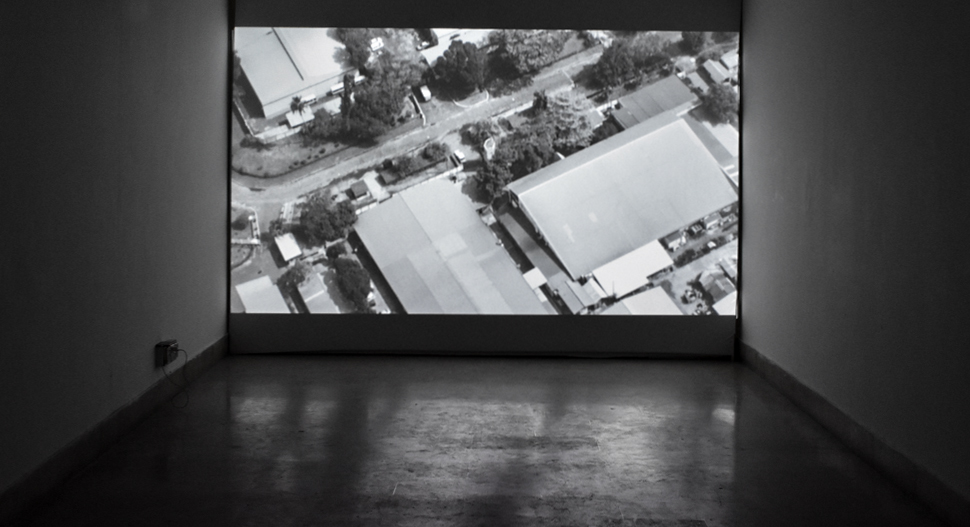
Katunayake Free Trade Zone, 2015.
Black and white HD-video as projection, no sound, 15 min.
Courtesy the artist

Jesús Hdez-Güero
Born in 1983 in Havana (Cuba)
Lives and works between Havana (Cuba) and Caracas (Venezuela)
Jesús Hdez-Güero
Born in 1983 in Havana (Cuba)
Lives and works between Havana (Cuba) and Caracas (Venezuela)
Jesús Hdez-Güero attended the San Alejandro Academy of Fine Arts, Havana, between 1999 and 2003. He later entered the Instituto Superior de Arte (ISA) in Havana, earning his degree in Fine Arts in 2009. His work is not limited to a specific artistic medium, but depends on the idea to develop. His works have been presented in different exhibitions, including: Desplazamientos, la mayoría invisible: A Nation in a Few Words, Alejandro Otero Museum (MAO), Caracas, Venezuela; The Object and the Image (This is not a Chair Either), Concrete Space Project, Miami, USA; 9th Edition of the IILA-PHOTOGRAPHY Prize, Museum of Contemporary Art (MACRO), Rome, Italy; Iconocracia: Contemporary Cuban Photography, Atlantic Center for Modern Art (CAAM), Las Palmas de Gran Canarias (2016) and the Basque Center for Contemporary Art (Artium), Vitoria, Spain (2015); Zona Franca, 12th Biennial of Havana, Historical-Military Complex Morro-Cabaña, Havana, Cuba; The Spaces Between: Contemporary Art from Havana, Bildmuseet, Umeå University, Sweden (2015) and at the Morris and Helen Belkin Art Gallery, Vancouver, Canada (2014); TOUCHED, Liverpool Biennial, Visitor Center, Liverpool, UK; Experimental Video and Video Art: Artists from Cuba, Antioquia Museum, Medellín, Colombia; VII Biennial of Gwangju, South Korea; and States of Exchange: Artists from Cuba, Institute of International Visual Arts (IniVA), London, UK.
The video Minutos de odio contra sí mismo (Minutes of hate against oneself) shows a close up of the Venezuelan flag receiving eight bullets, which, one by one, replace the stars that normally adorn it. In his work, the artist reflects on the attacks, mutations and re-significances of media, social and political discourse that have caused the flag, and the nation, to suffer to such an extent that violence has became an integral part of Venezuelan identity.

Still from Minutos de odio contra sí mismo, 2014-2015.
Video, 1:11 min. NTSC
Ed. 5 + P/A
Brillembourg Capriles Collection, US (Ed. 2/5)
Kadist (Sur) Collection, US (Ed. 3/5)
Curated by Carlos Acero Ruiz.
Jibran Shahid
Born in 1992 in Islamabad (Pakistan)
Lives and works in Rawalpindi (Pakistan)
Jibran Shahid is a multidisciplinary artist who works with drawing, painting and sculpture, specialising in the latter, to which he often applies ceramic techniques, with a particular interest in the medium of porcelain. He obtained his BFA from the National College of Arts, Rawalpindi in 2016, and his work has been exhibited locally. Shahid’s art practice is based in an exploration of classical beauty, from which point he deconstructs and then reassembles the basic component parts to create singular forms of hybridity.
Shahid’s artistic practice is epitomised by his ceramic sculpture for the Karachi Biennale 2017 entitled, Embrace of Death 2. By merging anatomical elements of the horse and the human figure, the artist develops the idea that the horse is an icon of human civilisation; at once befriended, domesticated, idolised and exploited by man, the hybrid form visually represents the cross-species entanglement. The highly-stylised form, deliberately exaggerated in parts, establishes the connection with the equine strength and power that has fascinated and inspired mankind throughout art history, and human history more generally. The evolution of the work’s hybrid form perfectly captures the aspects of the horse which have eternally characterised it as an expression of certain desiderata of human nature: unadulterated dynamism; aesthetic satisfaction; and spiritual aspiration.

Embrace of Death 2, 2017.
Cold porcelain, resin
243 x 91 x 76 cm.
Courtesy the artist


















